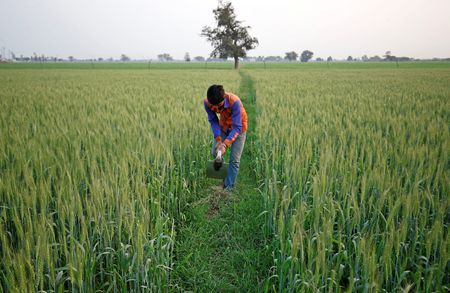By Rajendra Jadhav
MUMBAI (Reuters) -Indian farmers are set to expand wheat acreage by about 5% to a record high, aided by higher returns and October’s untimely rains, which improved soil moisture and encouraged a shift from rainfed crops to the cereal, industry officials told Reuters.
The higher planting is expected to help the world’s second-largest wheat producer boost output, ease local prices, and potentially enable New Delhi to permit limited exports of wheat flour.
“Given the higher soil moisture at this time due to increased rainfall, wheat sowing and production are expected to surpass all previous record highs,” Nitin Gupta, senior vice president at Olam Agri India, an agicultural commodity trader,told Reuters.
India’s key wheat-growing north-western region was inundated with 161% more rainfall than average in October, contributing to the country’s overall 49% surplus in the month.
Wheat was planted across 6.62 million hectares as of Nov. 14, up 17% from a year earlier, according to data from the Ministry of Agriculture & Farmers’ Welfare.
Planting for the 2025/26 season is expected to rise about 5% from last year’s record 34.16 million hectares, based on an average estimate from eleven industry officials.
Wheat acreage in the key northern states of Haryana and Punjab, which benefit from reliable irrigation, is expected to remain steady, while farmers in Uttar Pradesh, Madhya Pradesh, and Rajasthan are likely to shift from less-thirsty crops such as chickpea to wheat, industry officials said.
New Delhi’s decision to raise wheat purchase price by 6.6% to 2,585 rupees per 100 kg for the new season crop is also expected to attract farmers to the cereal, said Ajay Goyal, managing director of Shivaji Roller Flour Mills.
Optimal wheat yield depends on cold weather through the critical January-to-March period, said Gupta of Olam.
The La Niña weather pattern, historically linked to colder-than-normal winters across northern India, is likely to persist from December through February, according to India Meteorological Department.
“The temperatures in northern and central India have been dropping over the past few days, which is great news for the wheat crop,” said a Mumbai-based dealer with a global trade house.
India banned wheat exports in 2022, extending the prohibition as extreme heat shrivelled crops again in 2023. The unfavourable conditions contributed to lower wheat reserves, pushing prices to record highs and fuelling speculation the country would need imports for the first time since 2017.
Supplies have improved since and in 2025 India harvested a record crop of 117.5 million metric tons.
(Reporting by Rajendra Jadhav;)











